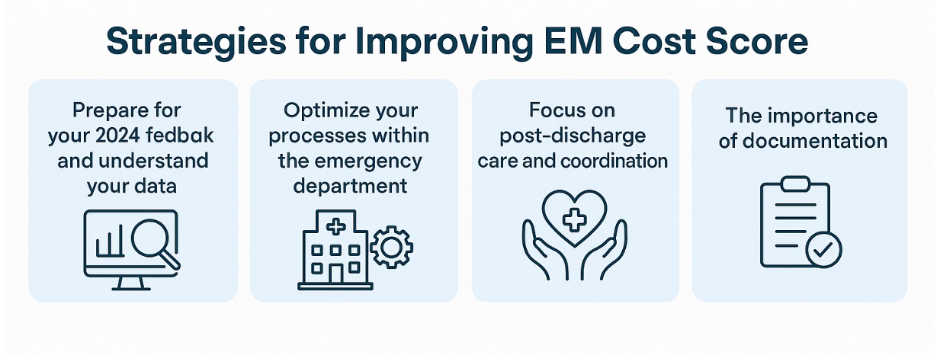The frantic pace, high-stakes decisions, and unpredictable patient flow of the emergency department make it a unique and challenging environment in healthcare. For years, the Merit-based Incentive Payment System (MIPS) program has presented a formidable obstacle for emergency physicians, and now the Cost category will have a measure just for emergency medicine in your 2024 feedback. This part of MIPS, which assesses the total cost of care for patients, can feel disconnected from the realities of emergency medicine, where the primary goal is rapid stabilization and appropriate disposition, not cost control.
The game, however, is changing. With new developments from CMS, a deeper understanding of how the MIPS cost measure works for emergency medicine is no longer just a good idea. It’s a necessity for your practice's financial stability and success.
The emergency medicine episode-based cost measure has been fully implemented for the 2024 performance year. That means it now accounts for a full 30% of your final MIPS score, directly impacting your Medicare reimbursement for the 2026 payment year.
This guide serves as a comprehensive roadmap, moving beyond the surface-level explanation to a detailed breakdown of the measure's mechanics, including the use of subgroups, risk adjustment, and actionable strategies you can implement to not only survive but also thrive in this new era of value-based healthcare.
Part 1: The core mechanics — a paradigm shift in cost measurement
The new emergency medicine cost measure represents a significant paradigm shift, introducing a more sophisticated methodology for treatment in the ED.
1. The power of 29 subgroups: a fairer peer-to-peer comparison
The most groundbreaking feature of this new measure is the use of 29 distinct subgroups. This is a crucial innovation that aims to solve the “apples and oranges” problem of cost measurement.

Instead of comparing all ED visits to a single, national average, CMS' methodology separates episodes into these subgroups based on a patient’s initial diagnosis (e.g., specific ICD-10 codes), age, and other clinical factors. This subgroup approach is a powerful tool for fairness. It ensures that your performance is evaluated against the performance of your peers who treated patients in that exact same clinical scenario.
For instance, if you treat a patient with a sprained ankle, your cost performance for that episode will be compared to the national average of other physicians treating similar patients with sprained ankles. You won’t be unfairly penalized by being compared to colleagues who manage complex, high-acuity cases like severe sepsis or a major trauma.
Your score is based on how you manage the cost of care for the patients you see, relative to the national average for that specific clinical situation. This is a massive step forward in ensuring the measure accurately reflects the value of the care you provide.
2. Risk stratification by admission status: acknowledging your most critical decision
The single most impactful decision an emergency physician makes is whether to admit or discharge a patient. This choice can be the difference between an episode of care costing a few hundred dollars and one that escalates to tens of thousands.
Recognizing this, CMS has built a critical layer of risk stratification into the measure: the cost measure is calculated differently for discharged patients versus admitted patients. This means that a patient you appropriately admit to the hospital with a complex, high-acuity condition will have their episode of care compared to other admitted patients in the same subgroup.
This essential stratification prevents you from being unfairly penalized for making the correct clinical decision that necessitates a higher-cost inpatient stay. The measure is designed to focus on the efficiency and appropriateness of care within the episode, not to penalize the high costs associated with necessary hospitalization.
Part 2: The episode of care — scope, exclusions, and attribution
To truly understand the measure, you must grasp the definition of an “episode of care” and how your actions within that timeframe are being evaluated.
Episode window: An episode is triggered by an ED visit and begins with the visit itself. It extends for 14 days after the trigger event. The costs included are those for all Part A and Part B services rendered during this 14-day window.
Attribution: The measure attributes a beneficiary’s episode of care to the emergency medicine clinician who bills for most of the ED visit services. This is based on the dollar amount of Medicare-allowed charges during the visit. This attribution methodology ensures that the responsibility for the episode’s cost is assigned to the clinician who had the most significant role in the patient's care during the initial visit.
Key exclusions: CMS has also tried to exclude costs that aren’t directly related to the ED care. The measure’s methodology includes a list of excluded services, which helps to further refine the cost calculation.
These exclusions help to ensure that your score is not impacted by unrelated, pre-existing conditions or long-term care outside the scope of your influence. For instance, some chronic care services or unrelated imaging studies may be removed from the calculation.
Part 3: Strategic action — how to thrive in the new landscape
The shift in the MIPS Cost category for emergency medicine isn’t a threat; it's an opportunity. By understanding the new rules and implementing a few strategic actions, you can demonstrate the immense value you bring to the healthcare system.
1. Prepare for your 2024 feedback and understand your data
The most critical step is to be prepared to receive your 2024 performance feedback, which is expected to be released in Fall 2025. When you get your report, don't just look at the final score. Dive into the details:
- Analyze subgroup performance: Examine your performance across the different subgroups. Where are you performing above the national average? Where are opportunities for improvement?
- Identify trends: Look for patterns. Are there specific types of patients or clinical scenarios where your costs consistently trend higher or lower?
- Focus on the “why”: The data will tell you what happened, but you must ask “why.” Are higher costs associated with specific ancillary services, lab tests, or imaging studies? Are they tied to bounce-back visits?
2. Optimize your processes within the emergency department
While you may not control post-discharge care, you can control what happens within your 4 walls.
- Evidence-based medicine: Continuously align your practice with evidence-based medicine guidelines. This is a foundational element of high-quality, cost-efficient care.
- Efficient resource utilization: Order tests, labs, and imaging judiciously. Ensure that every service ordered is clinically necessary and contributes to the patient's diagnosis and treatment plan.
- Leverage technology: Use your EHR and decision support tools to ensure you are following best practices and avoiding redundant services.
3. Focus on post-discharge care and coordination
For discharged patients, your role doesn't end when they leave the ED. The care they receive in the following 14 days directly impacts your Cost score.
- Robust discharge planning: Ensure every discharged patient receives clear, concise, and easy-to-understand discharge instructions. This should include follow-up recommendations, medication instructions, and red flags for when to return.
- Patient education: Empower patients with the knowledge to manage their conditions at home. Effective patient education can reduce the likelihood of unnecessary return visits or readmissions.
- Collaborate with your hospital system: Partner with case managers, social workers, and primary care physicians to ensure a smooth transition of care. This “warm handoff” can prevent costly gaps in care.
4. The importance of documentation
Your clinical documentation is the cornerstone of your performance on this measure. It’s used by CMS’ risk-adjustment models to understand the complexity of the patients you see.
- Be meticulous: Document all the patient's comorbidities, underlying conditions, and the full clinical picture. A detailed record ensures that the risk-adjustment model accurately reflects the acuity of your patients.
- Justify your decisions: Clearly document the medical necessity for all services, treatments, and disposition decisions. This narrative provides crucial context for CMS’ review.
To recap:

Conclusion: A new opportunity for recognition
The new MIPS cost measure for emergency medicine is a significant step toward recognizing the unique challenges and critical role of emergency physicians. By moving away from broad, one-size-fits-all assessments toward a more granular, risk-adjusted methodology, CMS is attempting to create a fairer system.
By understanding the use of visit types, subgroups, the importance of risk stratification, and the power of your clinical documentation and decision-making, you can turn this new measure from a source of anxiety into a powerful tool for demonstrating the immense value you bring to patients and the healthcare system. The time to prepare is now, so that when your 2024 feedback arrives, you’re ready to use the data to your advantage and thrive.
Need help making sense of these changes or preparing your strategy for 2026? Healthmonix is here to help. Contact our team to start building your cost strategy today.


